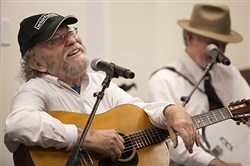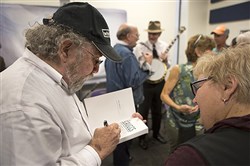VOL. 43 | NO. 43 | Friday, October 25, 2019
An American Classic
By Catherine Mayhew
Earl Scruggs stood straight. A fledgling banjo player for Bill Monroe’s Bluegrass Boys, Scruggs had just paid dearly out of his $60 weekly paycheck to have his pants dry cleaned. He knew if he sat down he’d ruin the crease.
Scruggs dressed impeccably for his performances, always wearing a suit and tie along with his signature “High Homburg” hat, a mark at the time of refinement.
He was a man of his time, a time when his brand of music was always in danger of being labeled “hillbilly.” Earl Scruggs was anything but a hillbilly. He was a revolutionary whose music and musical style would forever change the face of the instrument he loved and mastered.
Scruggs developed a signature technique, the Scruggs Style, of three-fingered playing that catapulted the banjo from backup instrument to featured performer.
As fellow musician Sonny Osborne once observed, “Earl has the whole pasture to himself; everyone else is just staring at the gate trying to figure out how to get in.”

Author Thomas Goldsmith, a musician before he was a writer, picks with friend John Hedgecoth, who played with Bill Monroe’s Blue Grass Boys.
-- Photo By Michelle Morrow | The LedgerAll of which is why author Thomas Goldsmith spent 12 years researching and writing “Earl Scruggs and Foggy Mountain Breakdown, The Making of an American Classic” (University of Illinois Press). But for Goldsmith, documenting a true American musical genius and the signature song that will forever be identified with him was not an academic exercise.
Goldsmith knew Scruggs personally.
As both a musician and award-winning music journalist, Goldsmith played with Scruggs informally and got to know his family. And that intimate familiarity shines in his book.
As Jay Orr, senior director for research, editorial and content at the Country Music Hall of Fame, noted in a public discussion he moderated at the museum recently, the reader can almost hear Scruggs speaking through the pages of the book because its author knew him well.
“You don’t know whether to be a musician or a writer,” Orr told Goldsmith during the discussion. “It’s the best thing written about Earl because it’s done with your knowledge of music and because you’re a good writer.”
Buy the Book
Purchase “Earl Scruggs and Foggy Mountain Breakdown: The Making of an American Classic,’’ is available at:
Goldsmith, who like Scruggs grew up in North Carolina, well remembers the first time he met the legendary musician and his wife, Louise. He was writing about music for The Tennessean.
“We got invited to Johnny Cash’s house,” he recalls. “It was June Carter’s party about a cookbook about Maybelle Carter’s cooking. And Cash was there, one of the truly, truly most impressive people I’ve ever met. But then I looked around and there was a round table like you’d have at a wedding reception and there were Earl and Louise sitting there by themselves.

Goldsmith during a recent book-signing event at the Country Music Hall of Fame.
-- Photo By Michelle Morrow |The Ledger“People said he was shy, he was reclusive and he didn’t talk to people. So I went over and said, ‘I’m Tommy Goldsmith from The Tennessean.’ And he was pleasant.
“And then I said, ‘I’m from North Carolina,’ and he lit up. We kind of bonded on that basis. And I got to be business friends with him. When something happened in the family, he would call me to get something in the paper when warranted. And we also started getting invited to parties of Louise and Earl’s, which were just insanely fun.”
Goldsmith mentioned during that first meeting that he also is a musician and got a surprising response from the low-key Scruggs. “He said, ‘You want to come out to the house and we’ll pick sometime?’
“And I said, OK. And a week or more passed, and I said to myself, ‘Earl asked you to come out and pick. Go do it.’ And I went and was so nervous I wrote down a bunch of songs I thought I could get through, and he was just completely pleasant.”
Over the years, Goldsmith interviewed Scruggs multiple times but the thought of a simple biography about him was never the object of the exercise. After Scruggs died in 2012, Goldsmith searched for a way to memorialize Scruggs and his ground-breaking musical style, settling on the idea of putting the musician into context by centering the book on his most famous composition, “Foggy Mountain Breakdown.”
“It’s generally accepted you need a narrative arc to writing, and frankly I really didn’t want to write just Earl’s biography,” Goldsmith explains. “So this allowed me to focus on his growing up, his development of the style, the development of “Foggy Mountain Breakdown.” That’s the tune that everybody knew.
“You could go into some roadside tavern in Botswana, and the jukebox has “Foggy Mountain Breakdown” on it. The other thing was I wanted to rescue the reputation of that song, which had become that kind of cheesy thing you played because everyone (in the audience) yelled for it.”
Scruggs developed his distinctive style while a young boy growing up in Flint Hill. It differs from previous popular banjo styles in that it uses a “three-finger” method with picks on the thumb, index and middle fingers. It was not unknown in some variation to other amateur musicians in Scruggs’ general locale, but in his hands it became something special.
“There were people around who played a variety of the three-fingered technique,” Goldsmith adds, “but he took it to another level. It’s kind of like going from Chaucerian English to the best modern writing you could think of.
“It was adaptable to different kinds of songs, different time signatures and it also was and is hypnotic to handle all those notes in a very well-thought-out useful manner.
“He just totally rose out of the pack. There’s some debate about how much of that style existed before but Earl codified it, elevated it. None of those other people rose up and went to the Grand Ole Opry and became a featured player and led their own band.”
Scruggs would go from winning local and regional picking contests to being invited to join Bill Monroe’s Blue Grass Boys, where he played with Lester Flatt.
The pair would leave the Blue Grass Boys to start their own band, the Foggy Mountain Boys. The next year they recorded “Foggy Mountain Breakdown.” It was not an immediate hit but started moving up the charts in 1967 because of its use in the movie, “Bonnie and Clyde.”
Throughout his life, Goldsmith says, Scruggs just loved the simple act of playing music. He would jam with the greats of country, bluegrass and rock music but he was just as happy sitting in a room with other musicians – well-known or not – picking the banjo.
“However styles may change, people hunger for music with roots, soul, honesty and energy,” Goldsmith writes.
“Earl Eugene Scruggs embodied those values as he introduced the world to the worthy banjo picking he heard, then transformed, while still living in the hills near Boiling Springs. Without him, that sound and the five-string banjo would likely have been cast aside.
“Instead, Scruggs saved them both, leaving music and culture richer for the ages.”